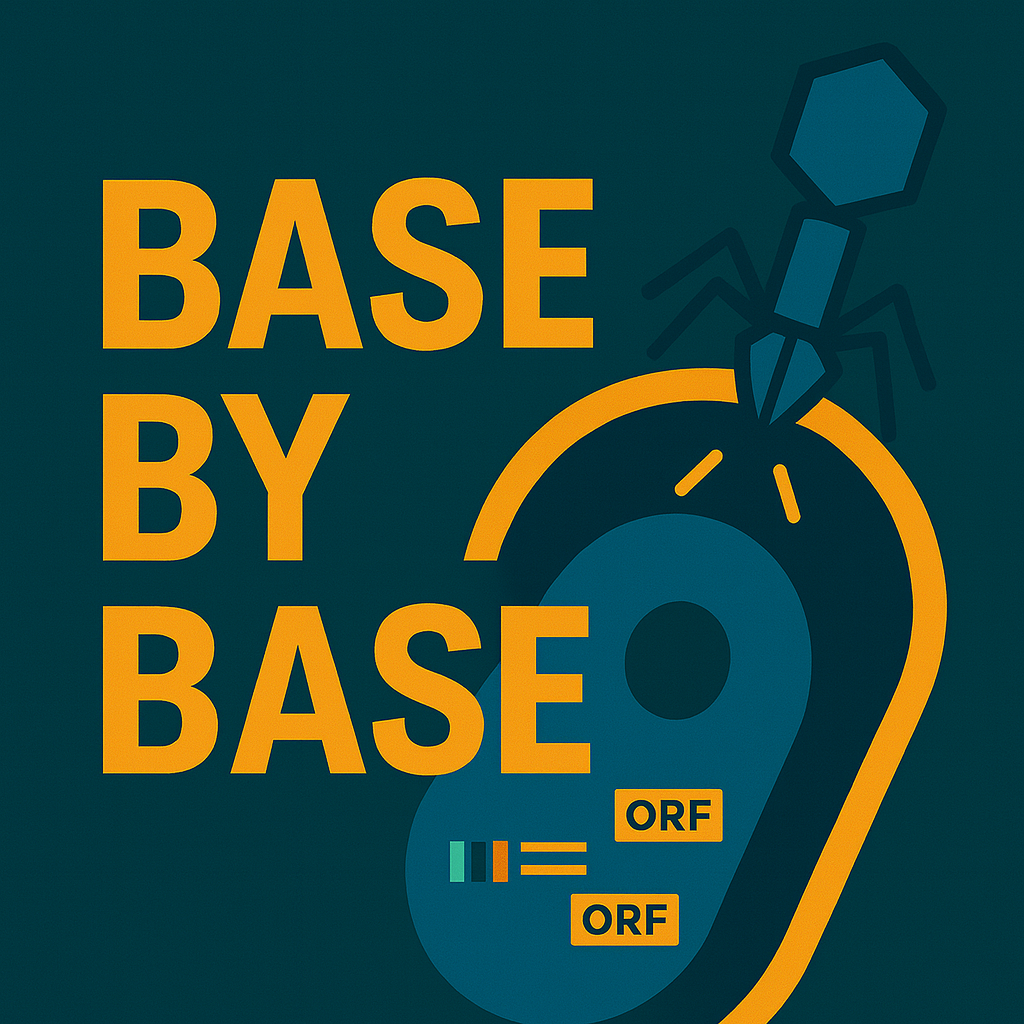Episode Transcript
[00:00:00] Speaker A: Foreign.
[00:00:14] Speaker B: Welcome to Base by Base, the papercast that brings genomics to you wherever you are. For most of us, when we picture DNA, we see that familiar, elegant double helix. It's the twisted ladder of life, right?
Scalable and predictable. But what if I told you that our genetic material is far more dynamic, that it's capable of forming surprising complex shapes that are, well, usually hidden from view? Imagine these unusual DNA structures, specifically called G quadruplexes aren't just biological curiosities. What if they are critical vulnerabilities, weaknesses that we can actually exploit to fight devastating diseases like cancer, Especially those aggressive blood cancers. Today, we're diving into a fascinating new study that explores just that. How stabilizing these peculiar DNA structures can cause targeted damage. Damage and cancer cells revealing, well, a powerful new strategy.
[00:01:02] Speaker A: Today we celebrate the groundbreaking work of the team at the University of California, Davis, particularly Irina Wesetrichra, Kalkada, Aylia Mehad, Hilal El Sheikha and Jacqueline H. Barloa. Their insights are really significantly advancing our understanding of G quadruple's role in genomic instability and B cell cancers. It's fantastic work.
[00:01:21] Speaker B: Okay, let's unpack this then. We're talking about G quadruplexes or G4S. You said for many people, like you mentioned, DNA is just that classic double hel.
What exactly are G4S and why do these non canonical structures matter so much in biology?
[00:01:37] Speaker A: Right. They are truly distinct. Unlike the typical double helix, they are four stranded secondary DNA structures, quite different. They form in sequences that are rich in guanine. The guanine stack up into these stable planar quartets. They're held together by unique chemical bonds, which makes them incredibly stable, actually. And these aren't rare occurrences. We've identified over 350,000 sequences with G4 forming potential in the human genome. Crucially, they're often found in vital regulatory regions of genes and at the origins where DNA replication kicks off.
[00:02:08] Speaker B: Wow. Over 350,000. So these G4s aren't just sitting there passively. They're embedded in really critical areas. What happens when these alternative structures actually appear during, say, normal cell processes like replication?
[00:02:20] Speaker A: Well, that's where they can become problematic. G4S can become significant obstacles. They can impair and even completely obstruct DNA replication. Imagine the cell's copying machinery, like getting jammed while it to duplicate its DNA.
That jamming is what we call replication stress. It throws the whole system into chaos potentially. And it's a common characteristic we see in many cancers, especially B cell cancers. And even in those hyperproliferative premalignant cells, replication stress.
[00:02:50] Speaker B: Yeah, that sounds like the cell is really being pushed to its breaking point, almost on the verge of breakdown.
[00:02:54] Speaker A: That's a good way to put it. Yes.
Genome instability arising from this stress is a definite hallmark of cancer. It directly contributes to the chromosome rearrangements we frequently observe in B cell cancers.
So this raises an important question for researchers. Can we weaponize this vulnerability?
And scientists have developed small molecules, these things called G4 stabilizing ligands, designed to bind to and lock these G4 structures into their problematic shape. And interestingly, human cells with mutations in DNA repair genes like BRCA1 or BRCA2, you know, often seen in aggressive cancers, they seem particularly sensitive to these compounds, which really hints at their therapeutic potential.
[00:03:34] Speaker B: So if these G4s create such a weakness, particularly in cells that are already compromised in DNA repair, that's a powerful idea. But for this to be a real therapeutic strategy, we need to know exactly how and where this damage is happening. How did the team even begin to map out such precise damage within something as incredibly complex as our DNA?
[00:03:52] Speaker A: Right, that was the goal. The researchers set out to precisely define the impact of these G4 stabilizing ligands on generating genome instability.
They specifically focused on comparing healthy primary B cells with malignant B cell lines, really trying to understand the differences.
[00:04:07] Speaker B: Okay, and what kind of tools did they use to get such a detailed look at the DNA damage? Because visualizing these tiny changes must be a huge challenge.
[00:04:15] Speaker A: They employed a, well, a powerful array of techniques. Their main G4 stabilizing compound was pyridostatin or PDS. It's known for its potency and selectivity.
And they also tested other G4 stabilizers like CX5461 and Phin DC3, just to confirm their observations were really specific to G4 stabilization, not some off target effect. And they cast a wide net with cell types, investigating various ones to ensure broad applicability. This included primary mouse B cells, both normal wild type and those with a BRCA1 mutation, alongside mouse lymphoma lines and several human B cell and cancer cell lines, too. Things like Rogibrichit's lymphoma, and importantly, even healthy human peripheral blood cells from donors. For a really comprehensive comparison, that's quite.
[00:05:01] Speaker B: The lineup of cells. How did they actually visualize the damage within these cells? I mean, on a chromosomal level?
[00:05:08] Speaker A: They used powerful microscopic and molecular techniques.
First, they literally looked at chromosomes under a microscope. They examined what are called metaphase chromosome spreads to identify those gross rearrangements. Things like breaks, fusions and dicentric chromosomes.
[00:05:25] Speaker B: Dicentric. Those are the ones with two attachment points instead of one.
[00:05:28] Speaker A: Exactly. Chromosomes with two centromeres. And they also spotted acentric chromosomes, the ones lacking any centromere, which often just get lost during cell division. Very unstable. Now, to precisely map where this damage occurred, they used fluorescence in situ hybridization, or esche.
[00:05:45] Speaker B: F. Esh. Right. Like a GPS for DNA.
[00:05:48] Speaker A: That's a great analogy. It uses fluorescent tags to light up specific regions. In this case, they looked at ribosomal DNA repeats, rDNA, and also pericentromeric major satellite DNA, or MASAT.
[00:05:58] Speaker B: And pericentromeric is.
[00:06:00] Speaker A: Think of it as the constricted waste of a chromosome near the centromere. It's crucial for how the chromosome moves and divides properly. Beyond just visuals, they used flow cytometry to track cell division and immunoblotting to see which key proteins controlling the cell cycle were active or inactive. They even used a clever step involving BRDU labeling. This let them track damage happening within just one cell cycle versus damage accumulating across multiple cycles.
[00:06:27] Speaker B: Okay, so they had all these advanced tools lined up. The stage was set. But what did the team actually uncover when PDS was let loose on these diverse cells? Did it confirm their suspicions? Or were there some surprising twists in the story?
[00:06:39] Speaker A: Well, they uncovered several really striking findings. First, PDS caused significant chromosom, and it was dose dependent. More PDS meant more damage. This effect was particularly pronounced in the mouse B cells that had that BRCA1 mutation. Those cells consistently showed more aberrations, like chromosome breaks in these two arm fusions, including those problematic dicentrics and the eccentric fragments.
[00:07:01] Speaker B: So the damage was clearly there. And it was worse in those vulnerable BRC01 mutant cells. But the critical question remains.
Was it just random chaos, or did it target specific locations within the genome?
[00:07:14] Speaker A: That's a vital question. Absolutely. And the answer is a resounding yes, it was targeted. The majority of PDS induced breaks weren't random at all. They occurred at distinct hotspots, Specifically, ribosomal DNA, the RDNA repeats and the starry centromeric major satellite, or MASAT repeats.
[00:07:30] Speaker B: Wow.
[00:07:31] Speaker A: For example, in the normal B cells, about 13.5% of all the aberrations involved RDNA, and a really remarkable 46.5% involved MASAT repeats.
[00:07:38] Speaker B: Almost half at MASAT.
[00:07:40] Speaker A: Exactly. This localization is. Well, it's a potential breakthrough. It means we're not just causing general chaos, we're Potentially targeting specific weak points. Almost like finding the exact keyhole for a specific lock within the cancer cell's DNA. And this level of precision is what makes G4 stabilization so exciting, Especially since other agents that cause replication stress don't typically show this same specific pattern of damage. They also saw an increase in micronuclei, these small extra nuclei, and about half of those contained MAS signals, and over 15% had rdna signals. It really reinforces these areas as primary targets.
[00:08:17] Speaker B: Wow. Targeted damage. That really is the holy grail in cancer therapy, isn't it? What does this level of precision potentially open up for future drug design? But hang on, there was something else you mentioned earlier. This idea of cells ending up with double the normal set of chromosomes. Tetraploidy.
[00:08:30] Speaker A: Indeed, yes. PDS also induced high levels of tetraploidy. This means cells ended up with double the normal set of chromosomes, four sets instead of two. Over 10% of the normal mouse B cells and nearly 20% of those BRCA1 mutant B cells became tetraploid after PDS treatment. And this tetraploidy was strongly linked to the appearance of those dicentral chromosomes, where two chromosomes fused together, creating a single, often unstable chromosome with 2 centromeres.
[00:08:59] Speaker B: So cells are getting double the chromosomes, and often these abnormal fused ones are popping up too. Did the normal cells and the cancer cells respond differently to this tetracoidy? Was there a difference there?
[00:09:09] Speaker A: Absolutely. And difference potentially for therapeutic strategy. While both the primary mouse B cells and the mouse CH12's lymphoma cells showed signs of tetraploidy developing, their fates were different. The primary B cells that became tetraploid, they actually proceeded into mitosis. They kept trying to divide even with the extra chromosomes. But, and this is key, in the CH12 lymphoma cells, those tetraploid cells got stuck. They got arrested in interphase, specifically activating a strong G2M cell cycle checkpoint.
[00:09:36] Speaker B: Ah, a cell cycle arrest.
[00:09:38] Speaker A: Exactly. This arrest prevented them from actually progressing into full tetraploid metaphases from trying to divide.
And the researchers confirmed this quite elegantly. If you artificially enforce that G2Mrs. In the primary cells, you prevent a tetraploidy. And conversely, if you disrupt the G2MRS. In the lymphoma cell, say with another drug, you actually induced tetraploidy.
[00:10:00] Speaker B: Wow.
[00:10:00] Speaker A: It's like the cancer cells have this built in pause button when faced with this specific stress. A button that the normal primary cells might not use way or they override.
[00:10:09] Speaker B: It that's a fascinating difference. It suggests a really different cellular response pathway being triggered. And how quickly did all this damage and these changes like the tetraploidy, appear within the cells? Was it immediate?
[00:10:22] Speaker A: Well, they found that PDS primarily causes those paracentromeric chromatic breaks within a single cell cycle. So the initial damage is quite rapid.
[00:10:29] Speaker B: Okay, pretty fast, yes.
[00:10:31] Speaker A: But the more complex chromosome breaks, infusions, like those dicentrics we talked about, those seem to accumulate over two or more cell cycles. This suggests maybe a multi step process where these initial simpler breaks can lead to more severe complex rearrangements over time if the cell keeps dividing.
[00:10:48] Speaker B: Right, A cascade effect.
So these detailed findings are mostly in mouse cells and some immortalized human cell lines. Do they apply to healthy human cells too? That's always the big question when you're looking at preclinical data, thinking about potential therapies.
[00:11:03] Speaker A: That's a crucial point. Absolutely. And they did look at that. PDS caused similar pericentromeric breakage in human immortalized and transformed B cell lines like GM12878 and the Raji lymphoma cells. It led to apoptosis and chromosomal instability there too. But here's a really key takeaway. PDS did not cause chromosomal instability in human peripheral blood mononuclear cells taken from healthy donors. Even at very high doses, the healthy human cells seemed largely unaffected.
[00:11:31] Speaker B: In this way, no damage in the healthy human cells?
[00:11:34] Speaker A: Not in terms of chromosomal instability, no. This is extremely significant because it suggests a potential therapeutic window, a dose range, where the drug might selectively harm cancer cells while leaving healthy cells, or at least these circulating immune cells, largely unaffected.
[00:11:50] Speaker B: That specificity, both in the location of the damage within the genome and apparently in the cell type affected, that sounds like a potential game changer. Does this specificity also imply potential limitations though? Or maybe specific challenges in say, drug delivery?
[00:12:06] Speaker A: That's a valid point we need to consider down the line. But connecting this back to the bigger picture, these findings are highly significant for understanding cancer vulnerabilities. We know G4S can act as replication barriers, and cancer cells often have this pre existing replication stress because of mutations in DNA repair factors like BRCA1 or BRCA2. So stabilizing G4s in these already stressed cells becomes a major obstacle. It pushes them further into instability and ultimately, hopefully towards cell death. This really makes G4 stabilization a very promising strategy, particularly for B cell cancer treatment.
[00:12:40] Speaker B: So we're essentially weaponizing a natural, albeit Unusual DNA structure against the cancer itself, turning an internal vulnerability into a targeted attack vector.
[00:12:49] Speaker A: Precisely. That's a great way to think about it. And the fact that PDS causes this recurrent damage, specifically at RDNA in repeats, is particularly insightful.
These aren't just random targets. The RDNA regions, for instance, are some of the most actively transcribed parts of the genome. So collisions between the transcription machinery and the replication machinery in these stabilized G4 areas, well, that can lead to significant DNA damage. And While actually detecting G4S in these repetitive pericentromeric regions has been tricky with traditional sequencing methods, this study provides strong functional evidence for their importance as sites of fragility.
[00:13:23] Speaker B: Right. Functional evidence is key.
Now, about the tetraploida you mention. It could be linked to tumorigenesis sometimes, but also to that beneficial cell cycle arrest in the lymphoma cells. This double edged sword aspect seems like a critical challenge. Understanding why some cells arrest and others might escape is surely paramount if we want to safely harness the strategy right. We wouldn't want to inadvertently fuel cancer.
[00:13:46] Speaker A: You've hit on a crucial point there. While polyploidies, including tetraploidy, is sometimes associated with the start of tumorigenesis, the strong G observed in the lymphoma cells here suggests it might actually be an early step towards programmed cell death apoptosis in that context, a sort of self destruct signal. In contrast, the G2M checkpoint escape seen in the primary V cells and Also the human GM12878 cell line, which led to metaphase tetraploidy. Well, that could be concerning. Tetraploid cells can sometimes bypass cell death signals and potentially contribute to cancer development or evolution later on. So this really highlights PDS and perhaps G4 stabilization in general as potentially being a double edged sword. It means we absolutely need further really in depth studies on the molecular pathways that control PDS induced tetraploidization in different cell types to fully understand the long term effects.
[00:14:38] Speaker B: Okay, so there are complexities to navigate, but the therapeutic potential, especially thinking about those hard to treat BRCA1 or BRCA2 deficient cancers, still sounds very promising despite these complexities.
[00:14:49] Speaker A: It absolutely does. PDS and maybe its chemical derivatives could emerge as excellent cancer therapeutics. They clearly cause DNA damage and trigger apoptosis in these BRCA12 deficient cancer cells, which are often particularly challenging to treat with standard therapies. They might also reduce oncogene expression, suppressing the very genes that drive the cancer's growth. And because PDS specifically Targets these pericentromeric regions, which interestingly, are already known to be fragile in many hematological cancers. It could potentially exacerbate those existing vulnerabilities, Effectively driving more cancer cell death hitting them where it hurts most.
[00:15:26] Speaker B: I also notice in the paper they combine PDS with other agents. What did that tell us about potential treatment strategies moving forward? Could combinations be key?
[00:15:34] Speaker A: Yes, and they found some impressive synergy there. For instance, combining PDS with something called a W E1 inhibitor, that's a drug that disrupts cell cycle checkpoints. Well, that combination dramatically increased chromosomal instability in the lymphoma cells compared to PDS alone. It's a very exciting finding because it really opens the door for potential combination therapies.
These could significantly enhance PDS's effectiveness, maybe lower the required dose, or potentially overcome resistance mechanisms that might develop.
[00:16:03] Speaker B: So, bringing this all together, what does this mean for future treatment development, taking all these exciting findings, but also the cautions into account?
[00:16:12] Speaker A: Well, the fact that PDS didn't seem to cause chromosomal instability in The Healthy Human PBMCs is a strong positive signal. It hints at a potential safety margin. However, this is a big however. Further in vivo studies are absolutely essential.
[00:16:28] Speaker B: In living organisms, Right? Not just cells in a dish.
[00:16:31] Speaker A: Exactly. In living systems, we need those studies to fully assess potential side effects throughout the body. We need to be cautious, especially given some previous reports suggesting PDS might have toxicity in primary neuronal cells, for example.
So we really need to understand the tissue specific effects and the nuances of this tetraploidization process in a whole living system before any clinical implementation could even be considered understood.
[00:16:54] Speaker B: Lots of promise, but careful steps needed. So if you were to boil it down, if our listeners take one thing away from our deep dive today, what would that central message be?
[00:17:04] Speaker A: I'd say it's stabilizing these unusual G quadruplex DNA structures with compounds like pyridostatin.
Effectively disrupts DNA replication. This disruption causes specific breaks, primarily in vulnerable repetitive regions like RDNA and the major satellite repeats near the centromeres. This leads to genomic instability and sometimes tetramoploidy. And critically, this targeted damage seems particularly effective in B cell cancers and especially those cells deficient in BRCA 1 or 2. So this targeted approach offers a genuinely promising new avenue for cancer therapeutics, One that works by selectively affecting tumor cells through their rDNA structures.
[00:17:41] Speaker B: A fascinating strategy, and it leaves us with a big what does this mean for developing new highly targeted therapies? Therapies that exploit these hidden vulnerabilities within cancer cells own DNA, potentially pushing them towards self destruction, maybe even while sparing healthy tissues. That's definitely a question worth pondering. This episode was based on an Open Access article under the CCBY 4.0 license. You can find a direct link to the paper and the license in our episode. Episode Description if you enjoyed this, follow or subscribe in your podcast app and leave a five star rating. If you'd like to support our work, use the donation link in the description. Thanks for listening and join us next time as we explore more science base by base.




